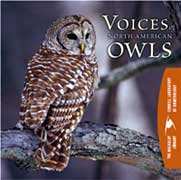"Owls have a rich repertoire of sounds for communicating in the dark," reports Cornell's Patricia Leonard. "They scream, chitter, squawk, squeal, bark, moan, trill, whine, chuckle, and clap their bills. And, yes, they hoot. Owls use these sounds to stake their claim on a territory, defend their homes from predators, and attract a mate. They have special sounds when begging for food, expressing alarm, or warning of danger."
For instance, what goes “wac-wac” and lives in a tree? Surprisingly: the Great Horned Owl.

For those interested in a quick course of those sounds, Voices of North American Owls is a new two-CD audio guide from the Cornell Lab of Ornithology that features nearly 200 tracks covering the 19 species of owls found in North America, and two rarities. A 56-page booklet with full-color images comes with it that describes the vocalizations made by each species and helps bird watchers with identification from the ghostly Barn Owl, to the tiny Elf Owl, to the familiar Great Horned Owl.
Some tracks are newly recorded. Others come from the archives of the Lab of Ornithology’s Macaulay Library. Voices of North American Owls sells for $29.95 and can be purchased online. To listen to sample sound tracks or for purchasing information, go here.
The Cornell Lab of Ornithology is a membership institution interpreting and conserving the earth’s biological diversity through research, education, and citizen science focused on birds.






Comments